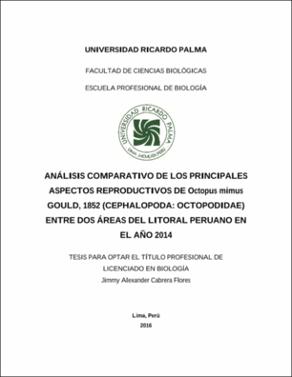| dc.contributor.advisor | Huamán Maita, Pedro | |
| dc.contributor.author | Cabrera Flores, Jimmy Alexander | |
| dc.date.accessioned | 2019-02-25T19:06:52Z | |
| dc.date.available | 2019-02-25T19:06:52Z | |
| dc.date.issued | 2016 | |
| dc.identifier.uri | https://hdl.handle.net/20.500.14138/1695 | |
| dc.description.abstract | Se realizó el análisis comparativo de los principales aspectos reproductivos del pulpo Octopus mimus Gould, 1852 entre las áreas de Callao y Chiclayo; utilizando bases de datos correspondientes a los muestreos quincenales de las capturas de la pesquería artesanal durante el año 2014. Se muestrearon 604 individuos (244 hembras y 360 machos) en Callao y 411 individuos (152 hembras y 259 machos) en Chiclayo. Este estudio tiene como objetivo aumentar el conocimiento sobre la biología reproductiva de la especie, y cómo se ve influenciada por las condiciones oceanográficas propias de un área.
Se determinó que ambas poblaciones no siguen los parámetros de una distribución normal, y que son estadísticamente diferentes con relación a la longitud del manto. Callao muestra una talla media anual mayor que Chiclayo. La proporción anual de sexos fue a favor de los machos. Resalta el predominio de individuos hembras y machos maduros durante todo el año. La talla de madurez obtenida, confirma que los machos maduran a tallas menores que las hembras. La talla de desove mantiene la tendencia. El peso de madurez en ambos sexos se encontró por debajo del peso mínimo de captura (1 kg), pero el peso de desove de las hembras fue mayor a éste.
El grado en que la condición del individuo se ve afectada por la reproducción, es más evidente y determinante en hembras.
La especie muestra un crecimiento alométrico negativo. En machos está mejor definido el aumento del peso de la gónada en función de la longitud del manto.
La influencia de los factores ambientales sobre el ciclo reproductivo es particular en cada área, lo que explica las diferencias en el biotipo y la estacionalidad de los eventos reproductivos.
A study was performed based on comparative analysis of the main reproductive aspects of Octopus mimus Gould, 1852 between the areas of Callao and Chiclayo; using databases corresponding to the bi-weekly sampling of the catches of the artisanal fishery for 2014. Were sampled 604 individuals (244 females and 360 males) in Callao and 411 individuals (152 females and 259 males) in Chiclayo. The aim of this study is to increase knowledge about the reproductive biology of the species, and how it is influenced by the oceanographic conditions characteristics of an area.
It was determined that both populations do not follow normal distribution parameters, and that are statistically different in relation to the length of the mantle. Callao shows a higher average annual size than Chiclayo. The annual sex ratio was in favor of males. Highlights the predominance of individuals mature females and males throughout the year. The size at maturity obtained confirms that males mature at smaller sizes than females. The size of spawning maintains the trend. The weight of maturity in both sexes was found below the minimum catch weight (1 kg), but the weight of spawning females was higher than this.
The degree to which the individual's condition is affected by reproduction is more evident and decisive in females.
The species shows a negative allometric growth. In males, the increased weight of the gonad depending on the length of the mantle is better defined.
The influence of environmental factors on the reproductive cycle is unique in each area, which explains the differences in the biotype and seasonality of reproductive events. | es_ES |
| dc.description.sponsorship | Submitted by Wong Rafael (rafel_wl@hotmail.com) on 2019-02-25T19:06:52Z
No. of bitstreams: 1
Cabrera_j.pdf: 1222869 bytes, checksum: 11669a3e2687540232f677370437a283 (MD5) | es_ES |
| dc.description.sponsorship | Made available in DSpace on 2019-02-25T19:06:52Z (GMT). No. of bitstreams: 1
Cabrera_j.pdf: 1222869 bytes, checksum: 11669a3e2687540232f677370437a283 (MD5)
Previous issue date: 2016 | es_ES |
| dc.description.uri | Tesis | es_ES |
| dc.format | application/pdf | |
| dc.language.iso | spa | |
| dc.publisher | Universidad Ricardo Palma - URP | es_ES |
| dc.rights | info:eu-repo/semantics/openAccess | |
| dc.rights.uri | https://creativecommons.org/licenses/by-nc-nd/4.0/ | |
| dc.source | Repositorio Institucional - URP | es_ES |
| dc.subject | pulpo | es_ES |
| dc.subject | Octopus mimus | es_ES |
| dc.subject | biología reproductiva | es_ES |
| dc.subject | Callao | es_ES |
| dc.subject | Chiclayo | es_ES |
| dc.subject | reproductive biology | es_ES |
| dc.title | “Análisis comparativo de los principales aspectos reproductivos de octopus mimus gould, 1852 (cephalopoda: octopodidae) entre dos áreas del litoral peruano en el año 2014.” | es_ES |
| dc.type | info:eu-repo/semantics/bachelorThesis | |
| thesis.degree.discipline | Biología | es_ES |
| thesis.degree.grantor | Universidad Ricardo Palma. Facultad de Ciencias Biológicas. Escuela Profesional de Biología | es_ES |
| thesis.degree.level | Título Profesional | es_ES |
| thesis.degree.name | Licenciado en Biología | es_ES |
| dc.publisher.country | PE | es_ES |
| renati.type | https://purl.org/pe-repo/renati/type#tesis | |
| renati.level | https://purl.org/pe-repo/renati/nivel#tituloProfesional | |
| renati.discipline | 511206 | |
| dc.type.version | info:eu-repo/semantics/publishedVersion | |


